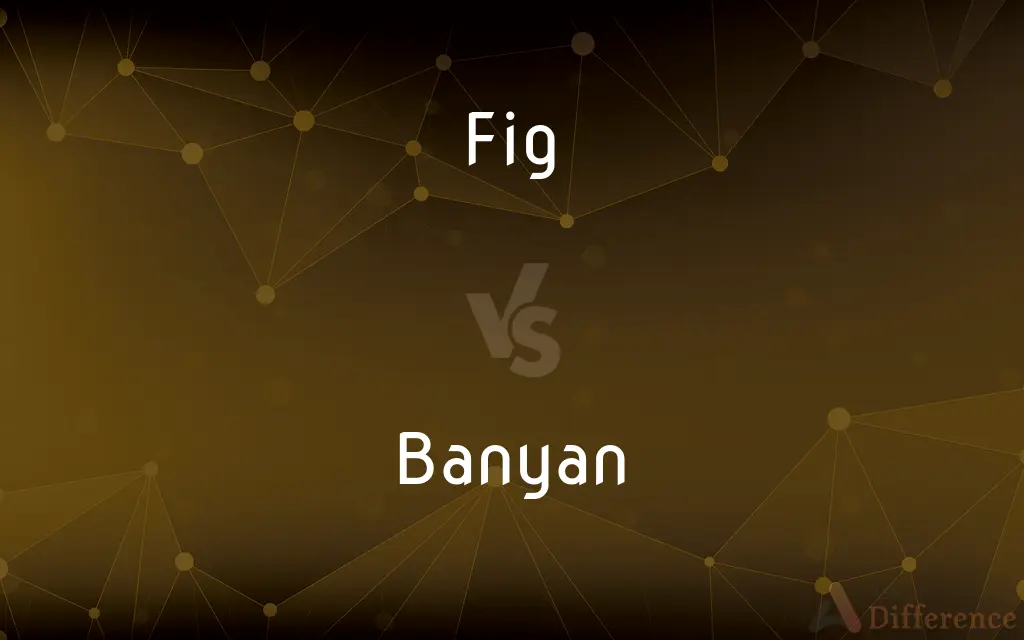Fig vs. Banyan — What's the Difference?
By Tayyaba Rehman & Urooj Arif — Updated on March 28, 2024
A fig is a type of fruit-bearing tree or shrub in the genus Ficus, known for its sweet fruit, while a banyan is a specific type of fig tree noted for its expansive canopy and aerial roots.

Difference Between Fig and Banyan
Table of Contents
ADVERTISEMENT
Key Differences
Fig trees, encompassing a wide variety of species within the genus Ficus, are cultivated globally for their delicious fruits and ornamental value. These trees can range in form from small shrubs to large trees and are characterized by their distinctive fruit, which contains numerous small seeds. The banyan tree, on the other hand, is a specific fig tree species, Ficus benghalensis, distinguished by its remarkable growth pattern. It starts its life as an epiphyte, growing on another tree, and gradually establishes itself on the ground through a complex network of aerial roots.
While all banyan trees are figs, not all figs are banyans. The primary distinction lies in the banyan's unique aerial root system and its cultural significance, especially in South Asia, where it is considered a sacred tree. In contrast, fig trees, more broadly, are appreciated for their fruit and as decorative plants in gardens and landscapes around the world.
Banyan trees are notable for their longevity and immense size, often becoming central landmarks in their locales. They serve not only ecological roles, providing habitat and sustenance to various species, but also social roles as gathering places. Fig trees, while also ecologically important, are primarily valued for their fruit production and aesthetic appeal in diverse climates.
In summary, the main differences between figs and banyans are found in their growth habits, the specific characteristics of the banyan's aerial roots, and their cultural and ecological impacts. Both, however, share the common trait of producing fig fruits, though the primary interest in banyan trees lies more in their architectural and cultural significance than in fruit production.
Comparison Chart
Scientific Name
Ficus spp.
Ficus benghalensis
ADVERTISEMENT
Characteristics
Varies widely; generally known for sweet fruit.
Known for vast canopy and extensive aerial roots.
Growth Form
Range from shrubs to large trees.
Starts as an epiphyte, developing into a large tree with secondary trunks.
Cultural Significance
Cultivated for fruit and ornamental use.
Considered sacred in many cultures, especially in South Asia.
Ecological Role
Provides habitat and food for wildlife.
Offers extensive habitat, stabilizes soil, and supports a diverse ecosystem.
Use
Fruit consumed fresh, dried, or in preserves.
Primarily ornamental or for shade; not commonly cultivated for fruit.
Distribution
Worldwide in temperate and tropical climates.
Native to India and Pakistan, widely planted in tropical regions.
Compare with Definitions
Fig
A fruit-bearing tree or shrub known for its edible sweet fruit.
The common fig (Ficus carica) is widely cultivated for its delicious fruits.
Banyan
A specific type of fig tree noted for its massive canopy and aerial roots.
The Great Banyan in India covers several acres with its canopy.
Fig
A plant with a wide range of species in the Ficus genus.
There are over 850 species of figs, each adapted to different environments.
Banyan
Begins life as an epiphyte, growing on other trees.
Many banyan trees start their life cycle growing on a host tree before establishing on the ground.
Fig
Culturally significant in many traditions, symbolizing fertility and prosperity.
Figs are mentioned in ancient texts and myths, symbolizing abundance.
Banyan
Sacred in many cultures, often associated with stories and legends.
Banyan trees are revered in Hinduism and Buddhism as symbols of immortality.
Fig
An important ecological species, serving as food for wildlife.
Fig trees provide critical sustenance to birds and mammals in tropical forests.
Banyan
Provides significant ecological benefits, supporting diverse wildlife.
The banyan tree's large canopy offers shelter and food to a wide array of species.
Fig
Versatile in culinary uses, from fresh consumption to jams.
Figs are enjoyed fresh, dried, or as part of various sweet and savory dishes.
Banyan
Can cover vast areas with its root system, forming additional trunks.
Banyan trees' aerial roots eventually thicken and become like several trunks.
Fig
Any of various trees or shrubs of the genus Ficus, especially F. carica, native to the Mediterranean region and widely cultivated for its edible multiple fruit.
Banyan
A banyan, also spelled "banian", is a fig that begins its life as an epiphyte, i.e. a plant that grows on another plant, when its seed germinates in a crack or crevice of a host tree or edifice.
Fig
The sweet, hollow, pear-shaped, multiple fruit of this plant, having many tiny seedlike fruits.
Banyan
A tropical Indian fig tree (Ficus benghalensis), often widely spreading because of the many aerial roots that descend from the branches and develop into additional trunks. It is planted for ornament and shade.
Fig
Any of several plants bearing similar fruit.
Banyan
An Indian trader, merchant, cashier, or money changer.
Fig
The fruit of such a plant.
Banyan
A tropical Indian fig tree, Ficus benghalensis, that has many aerial roots.
Fig
A trivial or contemptible amount
Not worth a fig.
Banyan
A type of loose gown worn in India.
Fig
Dress; array
In full fig.
Banyan
(India) A vest; an undershirt; a singlet.
Fig
Physical condition; shape
In fine fig.
Banyan
A camping excursion on shore, to give a ship's crew a break from shipboard routine.
Fig
To dress; to get oneself up a certain way.
Banyan
A tree of the same genus as the common fig, and called the Indian fig (Ficus Indica), whose branches send shoots to the ground, which take root and become additional trunks, until it may be the tree covers some acres of ground and is able to shelter thousands of men.
Fig
(obsolete) To insult with a fico, or contemptuous motion.
Banyan
East Indian tree that puts out aerial shoots that grow down into the soil forming additional trunks
Fig
(obsolete) To put into the head of, as something useless or contemptible.
Banyan
A loose fitting jacket; originally worn in India
Fig
To develop, or cause (a soap) to develop, white streaks or granulations.
Fig
(intransitive) To move suddenly or quickly; rove about.
Fig
A fruit-bearing tree or shrub of the genus Ficus that is native mainly to the tropics.
Fig
The fruit of the fig tree, pear-shaped and containing many small seeds.
Fig
A small piece of tobacco.
Fig
The value of a fig, practically nothing; a fico; a whit.
Fig
A raisin (dried grape)
Fig
The Lady Finger banana, also known as the "fig banana". (Cultivar of Musa acuminata.)
Fig
A small fruit tree (Ficus Carica) with large leaves, known from the remotest antiquity. It was probably native from Syria westward to the Canary Islands.
Fig
The fruit of a fig tree, which is of round or oblong shape, and of various colors.
Fig
A small piece of tobacco.
Fig
The value of a fig, practically nothing; a fico; - used in scorn or contempt.
Fig
Figure; dress; array.
Were they all in full fig, the females with feathers on their heads, the males with chapeaux bras?
Fig
To insult with a fico, or contemptuous motion. See Fico.
When Pistol lies, do this, and fig me likeThe bragging Spaniard.
Fig
To put into the head of, as something useless o contemptible.
Fig
A diagram or picture illustrating textual material;
The area covered can be seen from Figure 2
Fig
Mediterranean tree widely cultivated for its edible fruit
Fig
A Libyan terrorist group organized in 1995 and aligned with al-Qaeda; seeks to radicalize the Libyan government; attempted to assassinate Qaddafi
Fig
Fleshy sweet pear-shaped yellowish or purple multiple fruit eaten fresh or preserved or dried
Common Curiosities
How do fig trees benefit the environment?
Fig trees provide essential food and habitat for wildlife and play a key role in forest ecosystems.
What makes a banyan tree different from other figs?
A banyan tree is unique for its aerial roots that form additional trunks, creating a vast canopy.
What is the significance of fig trees in ecology?
They are keystone species in many ecosystems, providing critical food resources for numerous animals and contributing to habitat complexity.
Can banyan trees be grown in gardens?
Banyan trees can be grown in large gardens or parks in tropical climates but require ample space to accommodate their expansive growth.
Can you eat banyan tree figs?
While banyan tree figs are technically edible, they are not commonly consumed due to their taste and texture.
What are the common uses of figs?
Figs are used in a variety of culinary applications, including fresh, dried, in jams, pastries, and savory dishes.
Why are banyan trees considered sacred?
Banyan trees are considered sacred in many cultures due to their longevity, size, and the shelter they provide, symbolizing life and fertility.
How do banyan trees grow so large?
Banyan trees grow large through their unique propagation method, where aerial roots grow downwards, form secondary trunks, and spread over large areas.
Where are fig trees native to?
Fig trees are native to various regions, from the Mediterranean to Asia, but have been widely cultivated and naturalized around the world.
What cultural roles do figs play?
Figs have historical and religious significance in many cultures, often representing peace, prosperity, and fertility.
Share Your Discovery

Previous Comparison
Parmigiana vs. Schnitzel
Next Comparison
Chymotrypsinogen vs. ChymotrypsinAuthor Spotlight
Written by
Tayyaba RehmanTayyaba Rehman is a distinguished writer, currently serving as a primary contributor to askdifference.com. As a researcher in semantics and etymology, Tayyaba's passion for the complexity of languages and their distinctions has found a perfect home on the platform. Tayyaba delves into the intricacies of language, distinguishing between commonly confused words and phrases, thereby providing clarity for readers worldwide.
Co-written by
Urooj ArifUrooj is a skilled content writer at Ask Difference, known for her exceptional ability to simplify complex topics into engaging and informative content. With a passion for research and a flair for clear, concise writing, she consistently delivers articles that resonate with our diverse audience.
















































